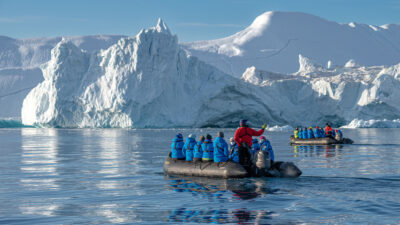Article | Northwest Passage
Part 3: Gory, Glorious, Uproarious—The British Admiralty's Quest for the Northwest Passage
By Aaron Spitzer | October 09, 2020
Related expedition: The Northwest Passage

© Dennis Minty
Beechey Island, Nunavut
Article | Northwest Passage
By Aaron Spitzer | October 09, 2020
Related expedition: The Northwest Passage

© Dennis Minty
Beechey Island, Nunavut
Read Part 2 of Aaron Spitzer’s four-part series! Gory, Glorious, Uproarious—Early Europeans and the Search for the Northwest Passage
When the Napoleonic Wars concluded, Britannia ruled the waves. With the greatest navy in world history but no clue what to do with it, they sought geographic glory. In time, this obsession would lead Scott to die in Antarctica, Mallory to die on Everest, and Fawcett to die in the Amazon. But before that, the British Admiralty embarked on a quest to solve the Northwest Passage—sending Franklin to die in Arctic.
The quest didn’t start tragically. It launched in 1818 with John Ross, who made the first modern contact with the Inughuit of Greenland’s far north, but retreated from Lancaster Sound after encountering the apocryphal Croker Mountains. The next year the admiralty sent the less-timid William Edward Parry, who, crossing the sound, became the first European to enter the passage. Thanks to lucky weather, he nearly reached the Beaufort Sea.

© Mark Edward Harris
The historic site of the Hudson's Bay Company trading post at Fort Ross, Nunavut, honours explorers John Ross and his nephew, James Clark Ross.
At the same time, John Franklin was leading his first of three journeys north. In 1819 he headed overland from Hudson Bay, hoping to trace Hearne’s route down the Coppermine River and then chart the Arctic shores. He filled in a bit of the map, but his men paid the price. Some starved to death. Some walked off into the bush. Some were murdered and surreptitiously eaten. One was executed. Franklin himself was days, maybe hours, from death when he was rescued by the Dene chief Akaitcho. The horror of it all made Franklin a legend.

© Robert Hood
This 1821 illustration by Robert Hood depicts Dene chief Akaitcho with his son.
Fast-forward to 1845. By that time, thanks to another journey by Franklin and trips by other Britons, two things were clear. First, an ocean channel ran along the edge of the North American continent from the Beaufort Sea in the west to Boothia Felix in the east. Second, relatively open waters stretched through the Arctic islands from Baffin Bay southwest to Somerset Land. Was there a way through the middle? If yes, it was the Northwest Passage.
So out went Franklin for a third time, now old and fat but still beloved, on the most well-equipped, most ballyhooed polar expedition in history. His ships, of course, were the Erebus and Terror. His men—128 of them—included seasoned polar hands like Crozier and Gore. He had engines, steam heat, canned food, and cameras. Victory seemed certain. The months ticked by, then the years. No word.

An illustration of the HMS Erebus and HMS Terror, circa 1845, artist unknown
In the late 1840s, the first search missions were launched. They all hunted in the wrong place. But it was in this manner, more than any other, that the Arctic map was completed. It was not until 1859 that Franklin’s fate became clear. According to Inuit testimony and a note found in a cairn, the ships had become locked in ice, during which time Franklin had died. His men embarked overland, marching south across King William Island. They fell one by one, the living eating the dead. None returned to the western world. The wrecks of both the ships were recently located. They are presently being searched for journals, photos, or other evidence that might flesh out the details of this grisliest of Arctic tragedies.

© Bunny Laden
The underwater archaeology team at work at the Wrecks of the HMS Erebus and HMS Terror National Historic Site
Keep reading Aaron Spitzer’s four-part series! Part 4: Gory, Glorious, Uproarious—Amundsen and His Successors in the Modern Northwest Passage

©Dennis Minty
August 27 to September 12, 2024
From $13,995 to $28,495 USD
per person based on double occupancy
Save 25%
Applies to berth cost only

©Dennis Minty
September 12 to September 28, 2024
From $13,995 to $28,495 USD
per person based on double occupancy
Save 25%
Applies to berth cost only.

©Dennis Minty
August 16 to September 1, 2025
From $14,495 to $28,995 USD
per person based on double occupancy
Save 25% for a limited time!
Applies to berth cost only

©Scott Forsyth
September 1 to September 17, 2025
From $14,495 to $28,995 USD
per person based on double occupancy
Save 25% for a limited time!
Applies to berth cost only